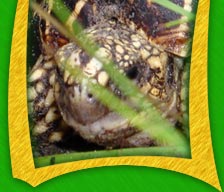|
 Photo Source: Brian Mealey
Photo Source: Brian Mealey |
KEEPING IT FRESH
Florida’s diverse freshwater systems are prime locations
for our low-laying friends. One area in particular, the Santa
Fe River is known for its wide array of aquatic turtles. During
the dry season, turtles from nearby lakes and ponds convene at
this location. Here, species like the Suwannee cooter, Florida
snapping turtle, and the Yellow-bellied slider keep a watchful
eye as they bask in the sun. Researchers from the Santa
Fe River Project estimate that 67% of North-central Florida’s
freshwater turtles can be found in or around this flowing body
of water; and for every one mile of river, there are approximately
500 turtles.
SOME LIKE IT SALTY
Sea turtles may be the most well-known saltwater species, but, the Diamondback
terrapin (Malaclemys terrapin) is a year-round resident of the Florida
Bay. In Key Largo, this gem-inspired reptile thrives in mangrove estuaries. Its
ability to tolerate high levels of salt makes it the only turtle in North America
native to brackish waters.
Despite the terrapin’s knack for all things
salty, the Diamondback faces a unique set of challenges. In
South Florida, scientists have discovered that females outnumber
males 10 to 1. It
is unclear whether greater predation upon the smaller male is to
blame, or if warmer nesting sands are the true culprit. (High-temperature
nests yield more females during incubation). Should this trend
continue, researchers believe the future of the Diamondback terrapin
could be in jeopardy.
HIGH AND DRY
North-central Florida is home to the Gopher Tortoise (Gopherus
polyphemus), a brownish-gray reptilian whose North American
ancestors date back nearly 60 million years. Although age
limits vary slightly, gopher tortoises or ‘gophers’ may
live in excess of 60 years. To identify the sex, males have a concave plastron or
bottom shell, whereas females possess a flat plastron.
It’s getting hot in here! These grass-loving animals
may live underground, but prefer to roam on dry, upland habitats
such as pine flatwoods, scrub, and coastal dunes. Fires,
both naturally-occurring and controlled, prevent vegetation from
growing tall and thick. By opening up the canopy, sunlight
reaches low-growing plants, such as herbs and grasses (a gopher’s
diet) that would otherwise die in the shade. To continue
the cycle of life, the tortoise promotes plant re-growth by dispersing
seeds found in its droppings.
Resources for this article
have been provided by the Gopher
Tortoise Council, the Corkscrew
Swamp Sanctuary and the Florida
Fish and Wildlife Conservation Commission.
|







